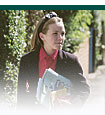|
Private schools are owned and governed by entities that are independent of any government—typically, religious bodies or independent boards of trustees. Private schools also receive funding primarily from nonpublic sources: tuition payments and often other private sources, such as foundations, religious bodies, alumni, or other private donors. In contrast, state and local education agencies (districts) and publicly elected or appointed school boards govern public schools. At some schools, parent/teacher organizations or similar groups also play a role. Public schools receive nearly all their funding from local, state, and federal governments, supplemented occasionally by grants/donations from corporations and foundations, and parent- or student-initiated fundraising activities.
Choice is another defining characteristic of private schools: families choose private education, and private schools may choose which students to accept. In contrast, public school districts generally assign students to particular schools, and those schools usually accept all students assigned. However, public school systems are expanding school choice options through magnet and charter schools, open enrollment, and similar offerings, and, in a few instances, through publicly funded vouchers. Families with sufficient financial resources have always been able to choose a public school by choosing where to live, but school choice options are also increasingly available for others. Thus, public school districts are sometimes selective about who attends specific schools, and families may have some choice within the public sector as well. The proportion of public school children attending a chosen school (rather than the school assigned by residence location) has increased in recent years (NCES 2002-025, indicator 29). In 1999, for example, 16 percent of public school students in grades 1–12 attended a school the family had chosen, up from 12 percent in 1993.
Nonpublic governance and enrollment choice are features that all private schools share, but there is wide variation within the private sector on many measures. This analysis highlights some elements of diversity among private schools (detailing some differences among three broad groups of private schools: Catholic, other religious, and nonsectarian) and notes several aspects that differ between the public and private sectors overall. More detail about the types and affiliations of private schools and their staffs, as well as additional comparisons between the public and private sectors, can be found in Broughman and Colaciello (2001); Baker, Han, and Keil (1996); Henke et al. (1996, 1997); McLaughlin (1997); and in a forthcoming NCES report on private schools.
Although this analysis compares averages for the private and public sectors (and for three private school types), no inferences can be drawn from these data about causality. Any number of variables distinct from school sector and type may contribute to inputs and outcomes. For example, student characteristics such as socioeconomic status (SES), prior achievement and support for learning at home, and motivation level may influence student outcomes, independent of the sector of school attended. Characteristics of schools such as enrollment size, community type, and student body composition may also affect outcomes, regardless of school sector. Further research may attempt to identify which variables contribute to certain outcomes—for example, a study may compare achievement of private and public school students while controlling for characteristics like SES—but that is beyond the scope of this brief analysis.
The data presented are from the NCES Schools and Staffing Survey (SASS:1999–2000), the National Assessment of Educational Progress High School Transcript Study of 1998 (NAEP:1998), the NAEP:2000 student achievement tests, and the National Education Longitudinal Study of 1988, "Fourth Follow-up" (NELS:1988/2000). Further information on these surveys can be found at http://nces.ed.gov/surveys/.
|



